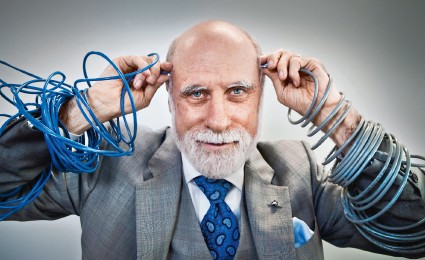

Think:Act Magazine “Accelerate and Reset”
The home office becomes the new normal

Think:Act Magazine
Why trust and autonomy are essential factors when working from home
Article by Geoff Poulton
Illustrations by DAQ Studio
WFH has become the abbreviation we all learned in 2020. But is the home office here to stay, or will the workplace become a little more homely too?
You can probably tell a lot about what matters to a society by its biggest buildings. The Egyptians had their pyramids, the Romans their aqueducts. Once upon a time, places of worship dominated a city skyline; now it's gleaming boxes of glass and steel, desks and whiteboards. For more than a century these boxes have grown upwards and outwards – bigger, better, more desks, more people. Until suddenly, a few months ago, the lights went out. Crippled by the coronavirus, the world froze and the temples of our modern society sat empty. They may never be full again.
The pandemic has shone a light on the way we work, revealing what some of us may have felt for some time: We don't always need to be in the office. We quickly found that, thanks to the wonders of modern technology, we actually can work productively at home. More work-life flexibility and autonomy? Yes please.

76% — The percentage of office workers in a Global Workplace Analytics study who want weekly work-from-home days even after the pandemic is over.
16% — The percentage of global office workers in the same study who say they never want to return to the office again.
Companies have recognized it, too. As lockdowns have eased, CEOs have allowed employees to continue working remotely. Dell told much of their workforce they could stay away from offices until the end of the year – and Google until July 2021. Facebook and Twitter will allow remote work forever, if a role allows. The sleep pods, cafés and wellness centers designed to keep employees at work as long as possible may be a thing of the past.
Organizations are rethinking their physical footprints. To the question of when at least 90% of their workforce will return to the office, just over a quarter of Fortune 500 CEOs replied "never." Morgan Stanley CEO James Gorman said the bank would need "much less real estate" in the future, while Barclays boss Jes Staley said there will be an adjustment in thinking about thousands of workers in a corporate office.
As companies shift from crisis management to planning the new normal, it's clear that the effects of Covid-19 on the way we work will long outlive the virus. "This is a massive culture change," says Tsedal Neeley , professor of business administration at Harvard Business School and author of the upcoming book Remote Work Revolution. "Some people still don't realize that; they think we might go back to how things were before. But we're not going back to a 'before.'" Breaking free of deeply engrained ways of working won't be easy, though. Prior to the coronavirus outbreak, few organizations had a detailed work-from-home policy with clear guidelines for employees.
Many still don't. But according to a post-Covid-19 global survey by Global Workplace Analytics, 94% of workers say they want to work from home at least occasionally in the future. Two-thirds said they work "very successfully" from home. There were once fundamental technological barriers to this, but now the digital toolkit for remote knowledge workers is incredibly effective and progressing at an astounding rate, says Andrew McAfee, co-director of the MIT Initiative on the Digital Economy and co-author of The Second Machine Age and Machine, Platform, Crowd. "What's more, recessions accelerate technological changes by driving efficiency," he explains. "We can expect many companies to deploy more tech over the coming months."

"We need macromanagers who create clarity with meaningful goals"
For many companies, the most pressing emphasis is on finding the right balance between remote and in-person work, learning how to manage remote teams and facilitating effective collaboration. These are all skills that will take time to master, says Tsedal Neeley. "Leaders are learning and improving as they go. Some have been too hands-off, leaving team members lost, while others have micromanaged to try and maintain stability, exacerbating already heightened levels of stress." Trust and autonomy are the most important factors in successful remote working.
A lot of managers are anxious, because they don't know how to make people produce when they can't see them, Neeley says. Desperate to ensure their employees aren't lounging around, some companies are even monitoring keystrokes and tracking other online behavior. "That's not helpful," she says. "We need macromanagers who create clarity with meaningful goals and purposeful roles. They have to learn to measure on outcomes not processes."
Of course, we didn't put large numbers of people in an office just to keep an eye on them. A virtual meeting doesn't have the same immediacy as a physical one and we can miss non-verbal cues, creating confusion and frustration. And while virtual teams can exploit existing knowledge to fuel speed and productivity, creation and innovation relies more on unstructured face-to-face encounters.
Managing communication is one of the hardest aspects to remote working. To find the right approach, companies must discuss how often team members should connect virtually during the week and with what tools. Some interactions might be more suitable for delayed communication platforms, like email, which allows team members time to think and prioritize before responding – a favored approach among experienced remote teams. Other topics might require instant communication tools, where team members interact in real time.
The limitations of videoconferencing, as well as an innate need for social interaction, mean that post-pandemic, those who can will likely split their time between remote and office work to make the best of both worlds. According to global research company Gartner, almost half of employees will work remotely at least part of the time.
43 — The number of minutes per day remote workers are distracted at home, compared with 78 in the office, according to Global Worklplace Analytics.
So what does that mean for the office? While nobody can say for sure how long some antiviral hygiene measures will be needed, the coronavirus outbreak has accelerated several underlying trends that look set to fundamentally change the workplace.
Simon Pole, global director of design at Unispace, an office design company, predicts companies will hand back 20-30% of their office footprint. What they keep will be 20-30% better, though, he says. "Traditionally, we planned the office around a sea of desks ... From now on, it will be more about bringing teams together to share knowledge and wisdom.
We're already seeing greater demand for communal spaces around problem-solving, innovation and socializing." Meeting spaces will become more informal, a pleasant side effect of conducting months of Zoom calls from living rooms and kitchens during lockdown.
According to Despina Katsikakis, head of occupier business performance at Cushman & Wakefield, a commercial real estate services firm, faceless, grey cubicles and meeting rooms will disappear as the office becomes a stronger embodiment of brand culture and values. "There'll be more focus on experiences, curated events, innovation and communities of mentoring. When people have more choice about where they work, you need to create an inspiring destination."
Cutting back on pricey city-center real estate could even lead to more fundamental changes in how we live and work. Instead of regularly commuting into central offices, workers could walk or cycle to local community work hubs, where they can connect with colleagues or other remote workers.
Facebook, for example, is already looking to build up hubs of work-from-home employees in Atlanta, Dallas and Denver. The experiences of recent months will lead a lot of people to conclude that they're very close to 100% effective as remote workers, says Andrew McAfee. According to Gartner, there are already a billion knowledge workers, many of whom need little more than a laptop and a decent internet connection.
Some will feel empowered to leave expensive city center living behind, accelerating the trend of 'digital nomadism.' According to one survey, while almost five million US workers already identify as "nomadic," more than three times as many would like to be. And it's not just workers that benefit from geographical freedom – employers benefit as well.
Sendible, a London-based software business, began to embrace remote work in 2019. "Suddenly, we could open our recruitment opportunities to the whole world," says the company's Martine Hammar. "We were no longer restricting our search to the UK, but able to recruit the most talented and qualified people we could find."
Remote work isn't for everyone, and when the pandemic eventually passes, some will still favor the daily interaction and work-life divide the office brings. But it is providing a genuine 'Wizard of Oz' behind-the-curtain moment that proves the facetime-obsessed office of the 20th century is over. It turns out that plenty of those meetings really could have been emails; some of those conferences could have just been watched online; and giving employees greater freedom and flexibility can make them happier and more productive.


_person_144.png)
_image_caption_none.jpg)





